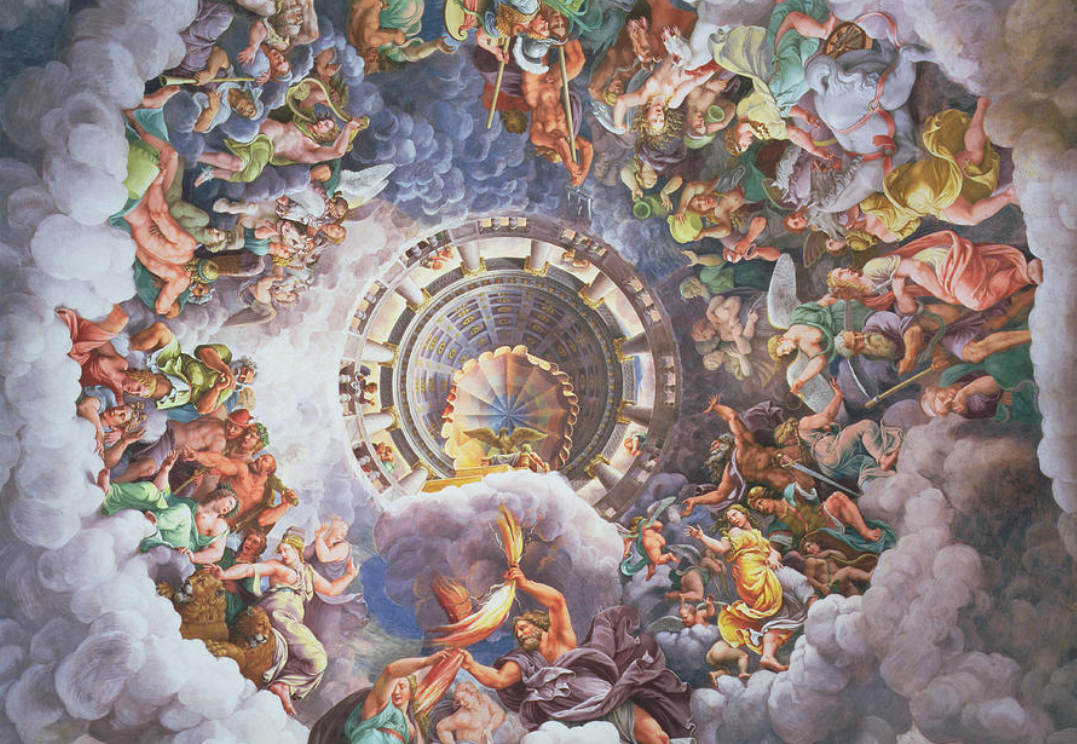
Today I want to talk about a book that all writers and lovers of history and mythology should have on their shelf: The Hero with a Thousand Faces by Joseph Campbell.
Every time I pick up this book, I’m struck by the truth of what Campbell says. I think of all of the stories that have struck a chord with me over the years, and the things they have in common. Campbell says:
“The archetypes to be discovered and assimilated are precisely those that have inspired, throughout the annals of human culture, the basic images of ritual, mythology, and vision… The hero… has died as a modern man – he has been reborn. His second solemn task and deed therefore… is to return then to us, transfigured, and teach the lessons he has learned of life renewed.”
(The Hero with a Thousand Faces; Joseph Campbell, Third Edition, 1973)
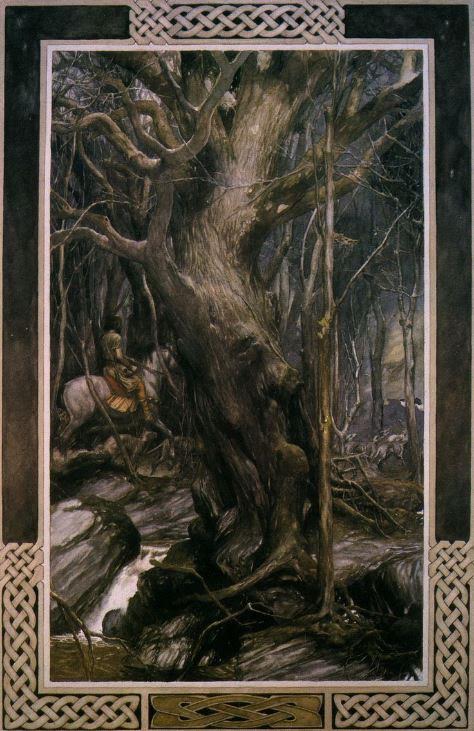
Pwyll, Prince of Dyfed (by Alan Lee)
If you stop to look at storytelling, past and present, you can indeed see the recurring themes and archetypes of myth. They’re everywhere. And this applies not only to western literature, but to storytelling across time, across cultures.
In studying Greek, Roman and Celtic literature and mythology, medieval and Arthurian romance, I’ve noticed that I’m drawn to certain elements. It’s not just because of the way these stories are told, or the language the writers or poets used. Let’s remember that the beauty of language is often lost in translation.
No. What draws me into these stories are common elements that appeal to something deep within my psyche, the blood in my veins, the fibre of my muscles, the dreams at the back of my mind. My inner youth, adventurer, lover, warrior, and wise man, all yearn for the stories that are food for the soul.
Without that food I begin to starve.
Such is the power of storytelling.
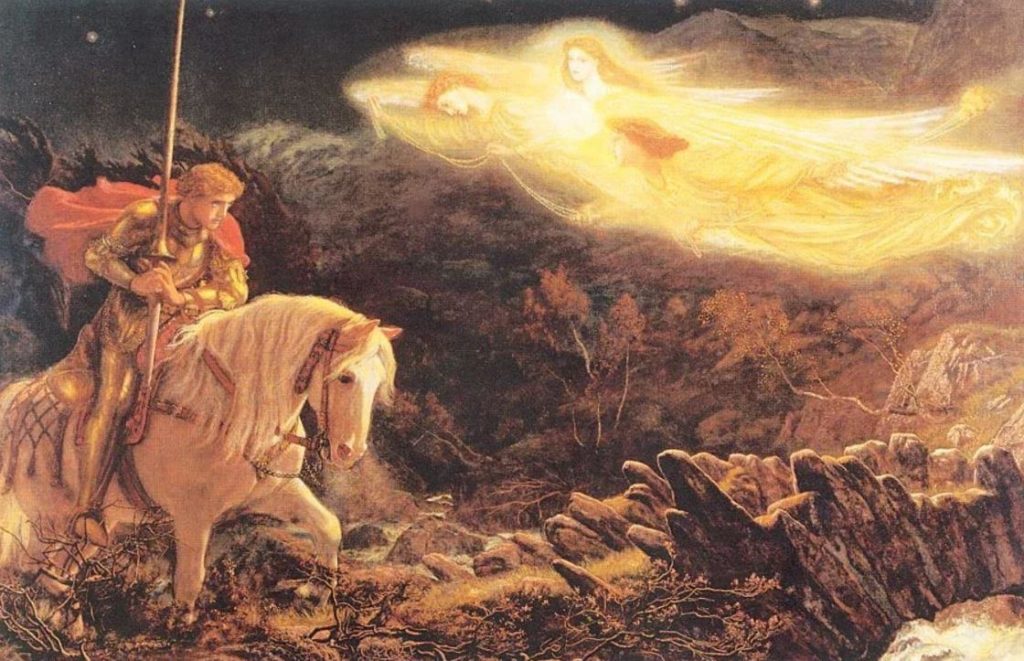
Sir Galahad upon his quest
The Hero with a Thousand Faces takes you into a world of great depth, of ideas and examples. There is too much to be able to do it justice in one blog post. However, in the book there is a chart of the Hero’s Journey that I believe can be infinitely useful to a writer and lifelong student of history and mythology.
Oftentimes, writers can get stuck, feel as though they’ve written themselves into a corner and are not sure how to get out of it. Perhaps they’re not sure where to turn next, which path their protagonist should take. Other times, a writer will wonder whether a certain path in the story will appeal to the reader, or else put them off so much that they go off in search of another adventure.
Campbell’s chart of the Hero’s Journey is an excellent point of reference, a tool or weapon to help a writer to get out of the traps that can halt the creative process.

(The Hero with a Thousand Faces; Joseph Campbell, p.245-246, Third Edition, 1973)
I think it prudent here to quote Campbell on what the journey entails:
“The mythological hero, setting forth from his commonday hut or castle, is lured, carried away, or else voluntarily proceeds, to the threshold of adventure. There he encounters a shadow presence that guards the passage. The hero may defeat or conciliate this power and go alive into the kingdom of the dark (brother-battle, dragon-battle; offering, charm), or be slain by the opponent and descend in death (dismemberment, crucifixion). Beyond the threshold, then, the hero journeys through a world of unfamiliar yet strangely intimate forces, some of which severely threaten him (tests), some of which give magical aid (helpers). When he arrives at the nadir of the mythological round, he undergoes a supreme ordeal and gains his reward. The triumph may be represented as the hero’s sexual union with the goddess-mother of the world (sacred marriage), his recognition by the father-creator (father atonement), his own divinization (apotheosis), or again – if the powers have remained unfriendly to him – his theft of the boon he came to gain (bride-theft, fire-theft); intrinsically it is an expansion of consciousness and therewith of being (illumination, transfiguration, freedom). The final work is that of the return. If the powers have blessed the hero, he now sets forth under their protection (emissary); if not, he flees and is pursued (transformation flight, obstacle flight). At the return threshold the transcendental powers must remain behind; the hero re-emerges from the kingdom of dread (return, resurrection). The boon that he brings restores the world (elixir).”
(The Hero with a Thousand Faces; Joseph Campbell, Third Edition, 1973)
As I read this, all the stories that I’ve ever loved flash through my mind. I see heroes such as Arthur, Frodo and even Luke Skywalker, taken from their quiet worlds and cast into the unknown with the aid of such legendary characters as Merlin, Gandalf, Obi-Wan Kenobi and others.

Luke Skywalker receives his father’s sword from and Obi Wan Kenobi
Often, a hero experiences an event that thrusts him into the adventure. I think of Odysseus being ordered to go to war at Troy and leave his wife and baby behind, or in the Mabinogi when Pwyll, Prince of Dyfed, goes into the otherworld of Annwn. Jason confronts Pelias and ends up on an expedition to find the Golden Fleece, the proposed price for getting back his father’s throne. There are so many examples. And often times, there is a sword: Arthur’s Excalibur, Luke’s father’s lightsaber or Bilbo’s sword, Sting, which goes to Frodo.
The tests are often what make up the bulk of the story which takes place in unknown realms. There are helpers in the form of other people, gods or animals along the way. In The Lord of the Rings, Frodo has the help of Aragorn (a hero on his own journey – a journey within a journey) and the rest of the Fellowship – elves, dwarves and others. Arthur has his knights who each have their own adventures. Theseus has Ariadne whose aid provides him with the key to the labyrinth. Jason gets aid from the blind prophet Phineas who tells him how to reach the Golden Fleece.
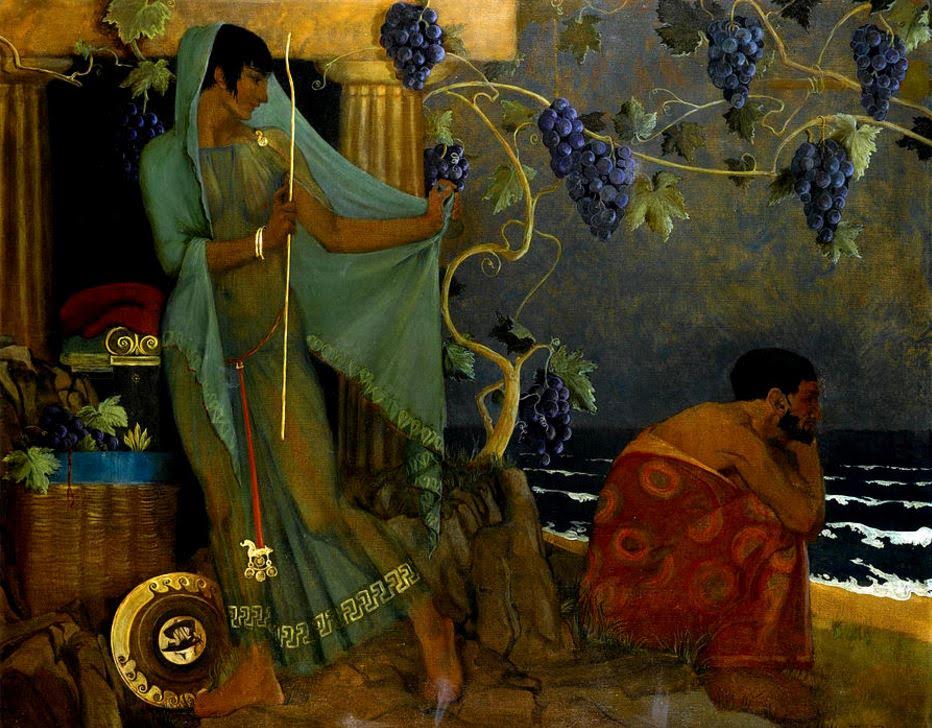
Calypso and Odysseus by Sir Wiliam Russell Flint
When the hero reaches what Campbell calls the ‘nadir of the mythological round’ there is an ordeal and reward. Odysseus passes through death in the form of Scylla and Charybdis to be washed up on the shore of the goddess Calypso’s island. He spends time there, loved by the goddess, and regains his strength before embarking on the final stages of his journey.

Jason and the Golden Fleece
Other themes at the ‘nadir’ are the attainment, by theft or gift, of the elixir that is sought by the hero. This could be the Golden Fleece, the Holy Grail, or the promise of a return home in the case of Odysseus. The promise of a healing of the land, of body, of spirit, is in the hero’s sights. But the journey is not yet over.
More challenges emerge before the hero can cross that threshold once more to get back into the known realms. Arthur must face Mordred, Odysseus must still reach Ithaca before destroying the suitors and taking back his home. Luke must escape the Death Star to destroy it in a final battle.

Arthur receives Excalibur
Once the final confrontations are overcome or dealt with, the hero achieves peace for himself and his realm, an overall healing of wounds and righting of wrongs that gives way to a golden time. If the hero dies in the attempt, he goes on to a better place and his example will be one that inspires future generations (e.g. Arthur going to Avalon).
You can take almost any story from any culture and apply the elements Campbell mentions.
The elements of the hero’s journey are universal.
Because these archetypes, these themes, are a part of our storytelling tradition, we often include them automatically in our writing without thinking about it.
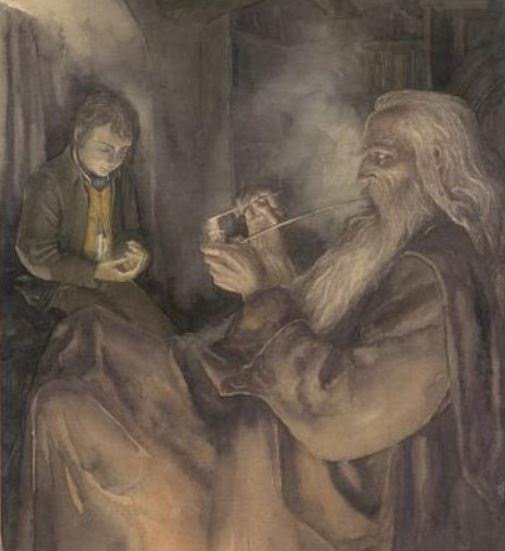
Frodo and Gandalf (picture by Alan Lee)
But a writer often is the hero on a journey, and doesn’t always know where the road will lead. We need helpers, a sword (or pen!), and certainly divine help and inspiration from the Muse should not be shunned. (Just read Steven Pressfield’s The War of Art for more on that!)
Sometimes writers need a guide like Joseph Campbell to put one back on track. And that’s ok!
Odysseus and Arthur, Luke and Frodo – they all had help. So did Pwyll and Yvain, Herakles and Jason. It’s not cowardly to receive aid. The true test comes when one decides what to do with the aid provided.
Whether I’m writing the first words, or flipping the first pages, of a new story, I relish the adventure to come, the trials and tribulations, learning from the unknown, and gathering the courage to slay my own dragons.
I like to think that that is what being human is all about. If you look at it a certain way, you’ll see that our stories are more a part of us than most people think. They’re not whimsical flights of fancy that have no real relation to us as human beings. They’re a deep part of us, and if we ignore or forget those stories, we lose a bit of ourselves.

Sir Percival and the Grail
Thanks for reading!
If you would like to find out more, here are a few places to start:
Star Wars: The Magic of Myth – This is a fantastic book, not only for Star Wars fans but everyone with an interest in mythology. George Lucas was friends with Joseph Campbell and adhered closely to the ideas of the hero’s journey in the creation of his brilliant story ‘A long time ago… In a galaxy far, far away…’
The War of Art by Steven Pressfield – in this fantastic book, historical fiction author, Steven Pressfield, talk about writing, Resistance, and doing the work of the Muse. A must-read for any creative person!



